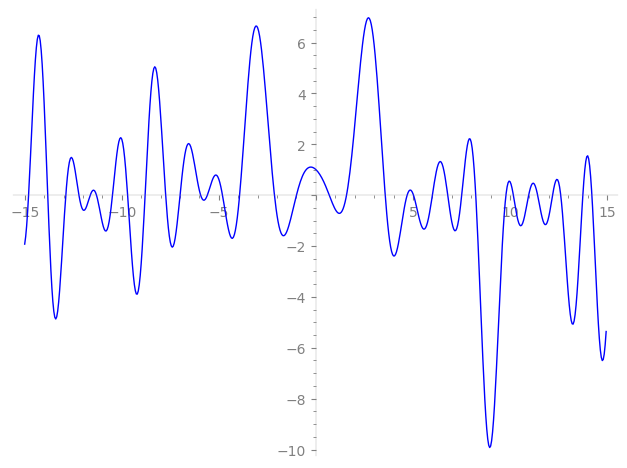| L(s) = 1 | − 3.25·3-s + (2.54 + 2.54i)7-s + 7.61·9-s + (0.462 − 0.462i)11-s + 1.33i·13-s + (2.37 + 2.37i)17-s + (2.69 − 2.69i)19-s + (−8.27 − 8.27i)21-s + (−2.10 + 2.10i)23-s − 15.0·27-s + (1.97 + 1.97i)29-s − 7.03i·31-s + (−1.50 + 1.50i)33-s − 7.81i·37-s − 4.34i·39-s + ⋯ |
| L(s) = 1 | − 1.88·3-s + (0.960 + 0.960i)7-s + 2.53·9-s + (0.139 − 0.139i)11-s + 0.370i·13-s + (0.575 + 0.575i)17-s + (0.618 − 0.618i)19-s + (−1.80 − 1.80i)21-s + (−0.438 + 0.438i)23-s − 2.89·27-s + (0.367 + 0.367i)29-s − 1.26i·31-s + (−0.262 + 0.262i)33-s − 1.28i·37-s − 0.696i·39-s + ⋯ |
\[\begin{aligned}\Lambda(s)=\mathstrut & 1600 ^{s/2} \, \Gamma_{\C}(s) \, L(s)\cr =\mathstrut & (0.604 - 0.796i)\, \overline{\Lambda}(2-s) \end{aligned}\]
\[\begin{aligned}\Lambda(s)=\mathstrut & 1600 ^{s/2} \, \Gamma_{\C}(s+1/2) \, L(s)\cr =\mathstrut & (0.604 - 0.796i)\, \overline{\Lambda}(1-s) \end{aligned}\]
Particular Values
| \(L(1)\) |
\(\approx\) |
\(1.003961620\) |
| \(L(\frac12)\) |
\(\approx\) |
\(1.003961620\) |
| \(L(\frac{3}{2})\) |
|
not available |
| \(L(1)\) |
|
not available |
\(L(s) = \displaystyle \prod_{p} F_p(p^{-s})^{-1} \)
| $p$ | $F_p(T)$ |
|---|
| bad | 2 | \( 1 \) |
| 5 | \( 1 \) |
| good | 3 | \( 1 + 3.25T + 3T^{2} \) |
| 7 | \( 1 + (-2.54 - 2.54i)T + 7iT^{2} \) |
| 11 | \( 1 + (-0.462 + 0.462i)T - 11iT^{2} \) |
| 13 | \( 1 - 1.33iT - 13T^{2} \) |
| 17 | \( 1 + (-2.37 - 2.37i)T + 17iT^{2} \) |
| 19 | \( 1 + (-2.69 + 2.69i)T - 19iT^{2} \) |
| 23 | \( 1 + (2.10 - 2.10i)T - 23iT^{2} \) |
| 29 | \( 1 + (-1.97 - 1.97i)T + 29iT^{2} \) |
| 31 | \( 1 + 7.03iT - 31T^{2} \) |
| 37 | \( 1 + 7.81iT - 37T^{2} \) |
| 41 | \( 1 - 2.17iT - 41T^{2} \) |
| 43 | \( 1 + 3.10iT - 43T^{2} \) |
| 47 | \( 1 + (-0.0727 + 0.0727i)T - 47iT^{2} \) |
| 53 | \( 1 - 0.719T + 53T^{2} \) |
| 59 | \( 1 + (-8.67 - 8.67i)T + 59iT^{2} \) |
| 61 | \( 1 + (7.10 - 7.10i)T - 61iT^{2} \) |
| 67 | \( 1 - 10.8iT - 67T^{2} \) |
| 71 | \( 1 - 15.3T + 71T^{2} \) |
| 73 | \( 1 + (0.905 + 0.905i)T + 73iT^{2} \) |
| 79 | \( 1 + 3.90T + 79T^{2} \) |
| 83 | \( 1 - 6.02T + 83T^{2} \) |
| 89 | \( 1 + 7.46T + 89T^{2} \) |
| 97 | \( 1 + (-3.74 - 3.74i)T + 97iT^{2} \) |
| show more | |
| show less | |
\(L(s) = \displaystyle\prod_p \ \prod_{j=1}^{2} (1 - \alpha_{j,p}\, p^{-s})^{-1}\)
Imaginary part of the first few zeros on the critical line
−9.698278705318771562725641253840, −8.798053454544392954869369315400, −7.73775974227034847744112780906, −6.99648946339114881524908025761, −5.93753003230493243964073066423, −5.59073259529243583108737441036, −4.81285413444097111362612858091, −3.92994067594803424756672499245, −2.13528872047573130113659107369, −1.00093520994289727455121748377,
0.68753709649051758594897500617, 1.57727761619813214359486376043, 3.57050048510989273594187907560, 4.69980469134094898567875202828, 5.02596684953034616374062418252, 5.99971960784572010112452963813, 6.79080769212892132408962738910, 7.50983843552515434090850289118, 8.232987820852809302968524056575, 9.789082945564528083460268741155

